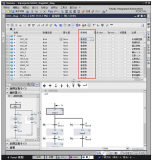static屬性一般是在編譯的時候就已經分配了內存,并被這個類的所有實例共享,
也就是在仿真時刻0之前就已經完成了靜態屬性的內存分配。
但是,參數化類中的靜態屬性可能有所區別。參數化類中的靜態屬性(參數化)是在參數初始化的時候才會分配。
// Class with parameters class with_param #(type T = int); static T static_with_p; endclass // Class without Parameters class without_param; static int static_wo_p; endclass module top; initial begin $display("static_wo_p = %0d", without_param :: static_wo_p); $display("static_with_p = %0d", with_param :: static_with_p); end endmodule: top
在上面的兩個class中,一個包含parameter (with_param),還有一個不包含parameter(without_param).
在各自class中,我們都聲明了靜態屬性。在訪問靜態屬性“static_wo_p”時沒有問題,而在訪問靜態屬性
“static_with_p”時,編譯器會報錯(Error或者Warning):
Warning-[PCSRMIO] Class scope used outside of class testbench.sv, 59 "with_param::static_with_p" An unspecialized class scope '::' reference was seen. To access a static member of the default specialization outside the class 'with_param', use 'with_param#( )::' instead. This will be an error in a future release.
需要修改成下面這樣的寫法才能編譯通過。
$display("static_with_p = %0d", with_param # ( ) :: static_with_p);
下面這個例子更能夠展示參數化類中的靜態屬性和非參數類中的靜態屬性的區別:
class with_param #(type T = int);
static T counter = 2;
function new;
counter++;
endfunction: new
endclass: with_param
class with_param_extend extends with_param #(real);
endclass: with_param_extend
typedef with_param #(byte) s_byte;
s_byte S1 = new( );
s_byte S2 = new( );
with_param S3 = new( );
with_param #(bit[2:0]) S4 = new( );
with_param_extend S5 = new( );
initial begin
$display ("Counter value of S1 instance = %0d", with_param
#(byte)::counter);
$display ("Counter value of S2 instance = %0d", s_byte::
counter);
$display ("Counter value of S3 instance = %0d", with_param
#()::counter);
$display ("Counter value of S4 instance = %0d", with_param
#(bit[2:0])::counter);
$ d i s p l a y ( " C o u n t e r
value of S5 instance =%0d",with_param_extend::counter);
end
仿真log:
Counter value of S1 instance = 4 Counter value of S2 instance = 4 Counter value of S3 instance = 3 Counter value of S4 instance = 3 Counter value of S5 instance = 3.000000 V C S S i m u l a t i o n R e p o r t
上面的例子中S1、S2、S3、S4、S5中的參數T分別被覆蓋成byte、byte、int、bit[2:0]、real,所以只有S1(s_byte)和S2(s_byte)中的靜態屬性counter彼此共享。
參數類的擴展類
class class1 #(type T = int); …. endclass class class2 #(type P = real) extends class1; class class3 #(type P = real) extends class1 #(integer); class class4 #(type P = real) extends class1 #(P);
上面是一個參數化類的擴展類示例,class1是一個參數化類,參數T默認為"int"。
class2增加了一個參數P,此時參數T為默認的"int"
class3增加了一個參數P,此時參數T覆蓋成"integer"
class4增加了一個參數P,此時參數T也覆蓋成為P
-
屬性
+關注
關注
0文章
23瀏覽量
8559 -
static
+關注
關注
0文章
33瀏覽量
10396
原文標題:參數化Class中的靜態屬性
文章出處:【微信號:芯片驗證工程師,微信公眾號:芯片驗證工程師】歡迎添加關注!文章轉載請注明出處。
發布評論請先 登錄
相關推薦
如何使SOLIDWORKS參數化設計軟件提升效率
如何使用ADC_PRO來測試ADC的INL與DNL等靜態特性參數?
請問靜態變量如何放到flash中?
FPGA設計中,對SPI進行參數化結構設計

FPGA設計中,對SPI進行參數化結構設計
如何調整S7-1500中S7-GRAPH FB的保持性屬性





 參數化Class中的靜態屬性
參數化Class中的靜態屬性










評論